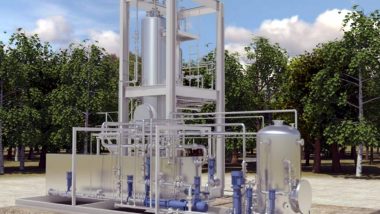The application of biogas in real-world uses has many advantages. First of all applying the biogas process (anaerobic digestion) is best known to be a renewable energy creator, and yet for some people the motivation in agriculture can increasingly be more to provide a waste management solution, than gain energy benefits.

Let's go back a step though to start, by considering the reason the application of biogas plants to the production of energy, is so good for the planet.
Biogas Production Applications are Climate Friendly
During the biogas production process, roughly an equivalent amount of carbon dioxide (CO2) is generated as is absorbed by the energy crops during their growth cycle, or as would be released naturally in the rotting of waste. This makes power and heat from biogas plants particularly climate-friendly. via methania.com
Being a climate-friendly, renewable heat source means that biogas production has a huge benefit pushing forward its use. The most common method of using biogas for energy production is through converting it into heat and electricity in combined heat and power (CHP) plants. For the most efficient use of biogas all new plants should incorporate CHP systems.
Top Applications of Biogas
The Top Applications (or Uses to which Biogas is Applied) of Biogas are:
- Electricity generation
- In combined heat and power (CHP) plants
- Waste Management in agriculture
- Cooking fuel as a sustainable energy source
- Injection into a natural gas pipeline
- As a Clean Renewable Fuel for Transport Vehicles
- In Biogas Fuel Cells..
Now we will look at each of these top biogas applications in turn, in more detail:
1. Electricity Generation
The application of biogas to electricity generation is the most common of all uses. Biogas made from plant material offers a renewable way to generate electricity. Unlike solar power available only during the day or wind power made only intermittently, biogas uses a reliable field crop grown and harvested by farmers. via news.uoguelph.ca
Biogas possesses chemical energy, and therefore electricity from biogas comes as a result of converting this chemical energy to mechanical energy and finally into electricity. This is done by the use of transducers such as generators and turbines that convert energy from one form to another. This electricity can be used both domestically and commercially since it can be made in small and large scale.
Connect the biogas source to the inlet of the gas engine. The biogas source may be a cylinder that contains pressurized gas or directly from a digester, which is the means of decomposing the organic material. The gas engine is designed to work in a similar manner to that of a car, since it is composed of pistons within which the gas is burnt and used to rotate a shaft, converting the chemical energy in the biogas into mechanical energy through motion.
Connect the gas engine to the AC generator in such a way that the rotating shaft powers the AC generator. The motion transferred to the AC generator produces electricity through magnetism. via Sciencing
2. In Combined Heat and Power (CHP) Plants
The application of biogas to produce combined heat and power should be as common as electricity generation, but the additional CHP plant requires additional investment, so the add-on equipment needed to use the waste heat may not be installed. Whenever that happens it should be seen as a missed opportunity. There is almost always a use to which the heat can be put, from electricity generation. Energy which would otherwise have to be wasted to the air around the cooling fans.
The valuable component of biogas is methane (CH4) which typically makes up 60%, with the balance being carbon dioxide (CO2) and small percentages of other gases. The proportion of methane depends on the feedstock and the efficiency of the process, with the range for methane content being 40% to 70%. Biogas is saturated and contains H2S, and the simplest use is in a boiler to produce hot water or steam.
The most common use is where the biogas fuels an internal combustion gas engine in a Combined Heat and Power (CHP) unit to produce electricity and heat. In Sweden the compressed gas is used as a vehicle fuel and there are a number of biogas filling stations for cars and buses. The gas can also be upgraded and used in gas supply networks. The use of biogas in solid oxide fuel cells is also being researched.
Biogas can be combusted directly to produce heat. In this case, there is no need to scrub the hydrogen sulphide in the biogas. Usually the process utilize dual-fuel burner and the conversion efficiency is 80 to 90%. The main components of the system are anaerobic digester, biogas holder, pressure switch, booster fan, solenoid valve, dual fuel burner and combustion air blower. via bioenergyconsult.com
3. Waste Management in Agriculture
After energy we rate the next most important application of biogas is for agricultural (livestock) waste management. Crop residues and manure can be digested either alone or in co-digestion with other materials, employing either wet or dry processes. In the agricultural sector one possible solution to processing crop biomass is co-digested together with animal manures, the largest agricultural waste stream.
In addition to the production of renewable energy, controlled anaerobic digestion of animal manures reduces emissions of greenhouse gases, nitrogen and odor from manure management, and intensifies the recycling of nutrients within agriculture.
Codigestion offers good opportunity to farmers to treat their own waste together with other organic substrates. As a result, farmers can treat their own residues properly and also generate additional revenues by treating and managing organic waste from other sources and by selling and/or using the products viz heat, electrical power and stabilized fertilization.
According to the government's Chinese Ecological White Paper issued in 2002, the total amount of livestock and poultry wastes generated in the country reached 2.485 billion tonnes in 1995, some 3.9 times the total industrial solid wastes. This illustrates just how big an issue agricultural waste is.
These wastes are precious resources if used properly, but constitute major pollution when discharged directly into rivers and lakes. It is estimated that less than 10 percent of the wastewater in China is currently treated, and that 10 million ha of farmland are seriously polluted by organic wastewater and solid wastes as well. via http://www.i-sis.org.uk/BiogasChina.php
It is true that farmers continually recycle their livestock waste by simply spraying it onto the fields, but it is far more hygienically done with less odor, lower pollution risk, and much better availability of nutrients, after first going through anaerobic digestion.
Jonathan Letcher notes in his book, “Farm Digesters” that only about half of the nitrogen present in livestock waste when ordinarily untreated and spread as “muck” onto fields is available for plant uptake. The rest is organic nitrogen still held in the fibrous material in cells yet to degrade. It generally takes a years or more before that 50% of the waste material breaks down by the action of bacteria in the ground, and can be used by the growing crop.
On the other hand, if the livestock waste first goes through an anaerobic digester, the bacteria convert the organic nitrogen present in the manure or slurry into nitrates. This is the form in which it can easily be adsorbed by plants. Furthermore, good farm management which ensures that the digester output, “digestate“, is spread during the growing season, can mean that the farm's nutrients can be much more efficiently used when the farm has an operational biogas plant.
Observers of crops which are fertilized with digestate frequently comment that the crop not only grows well, but it also looks much healthier. Darker greens are noticed, and fewer damage takes place from pests and disease. Many attribute thees benefits of biogas plant fertilizer to the rise in healthy bacteria and other micro-organisms in the soil after regular application of digestate.
Farmers which run their own digesters have reported that their need for expensive chemical fertilizer reduces by at a third to half, after commencing use of digestate fertilizer. This can amount on a good sized farm to a thrid of a million GBP saving ($400,000) annually.
4. Biogas Applied to Use as a Cooking Fuel – A Sustainable Energy source
The application of biogas for cooking and baking is a promising option for improving the energy supply of the poor, i.e. over 2.7 billion people who rely on the inefficient and unhealthy burning of biomass as main energy source.
Provided the biogas is properly combusted, biogas stoves produce the lowest level of greenhouse gas emissions compared to other technologies that use fuel combustion, e.g. biomass or fossil fuels. In this context, biogas stoves may help to reduce the impact on climate change of cooking practices in rural areas.
Stoves and ovens using biogas have the potential to improve the well being of marginalized people.
They offer an excellent opportunity to put an end to the indoor pollution generated in the kitchens of many poor families around the world, as well as treating organic waste that commonly represent health and environmental threats. This can have positive impacts on the vicious cycle of poverty. However, biogas solutions for cooking depend (in the first instance) on the technical feasibility of users producing their own fuel (biogas).
Thus, broad diffusion of the technology as an application of biogas requires thorough assessment of potentials and requirements of potential users.
The production of fuel wood and charcoal has resulted in deforestation and soil erosion in some regions. Increasing population and declining wood resources will further worsen the situation. One cubic meter of biogas can replace 5.6kg firewood and 1.7kg charcoal.
Additionally, the by-product of biogas production (the digestates) can be directly used as fertilizer or for the production of humus (e.g. cooking with biogas where possible)) can significantly reduce deforestation and help to mitigate soil depletion.
However, these advantages for the application of biogas depend on the quality of the biogas stove (particularly the burner).
Partial combustion results in a considerable portion of the methane contained in biogas being released un-burnt into the atmosphere. Methane is 20 to 60 times more powerful than carbon dioxide in causing climate change. Partial combustion of biogas also results in a high content of toxic carbon monoxide in the exhaust gases.
In households that use biogas for cooking, people may benefit in terms of their well being (e.g. from better indoor air quality and time and cost savings). However, assuring the long-term adoption of the technology has proved difficult in many cases.
However, untended systems and dissatisfied users have negatively influenced the uptake of the technology in many areas.
Integrating the application of biogas into the daily practices of users appears to be an indispensable condition (and also a complex challenge) in ensuring the sustainable use (and diffusion) of the technology. via www.wisions.net
The switch to biogas in cooking is not without challenges. According to the IEA, with an increase in income, households do not simply switch from one fuel to another after the application of biogas. The use of multiple fuels in parallel may enhance energy security compared to reliance on a single fuel or technology. Besides, traditional food preparation processes are not easily being overhauled because of taste preferences and the familiarity of cooking with traditional technologies.
Nevertheless, in the long run and on a regional scale, households in countries that become more wealthy are generally projected to shift from cooking exclusively with biomass to using more efficient technologies, among which biogas can be one option (IEA, 2006, 2008).
Currently, low per-capita incomes and a lack of awareness of the benefits of more sustainable fuels provides an important barrier to the wholesale application of biogas. Therefore, financing investments in biogas installations, especially in least developed countries, is a problem.
Hence, financing programmes and additional incentives are clearly needed to deal with this general reluctance among the target group. In India, for example, many of the the application of biogas plants is concentrated on wealthier farms with a relatively large number of cattle). via www.climatetechwiki.org
5. Injection Into a Natural Gas Pipeline
To understand the application of biogas as a fuel added into fossil fuel natural gas supply pipelines, needs to be explained.
When purified to a suitable extent to be injected in a natural gas pipeline, the pure gas is usually called “biomethane”. Biomethane injected in this way is in demand in many countries where the population is keen to comply with climate change reduction methods. The gas industry calls the compressed biomethane “Renewable Natural Gas” or RNG.
The potential for RNG and biomethane in gas applications in the U.S. is virtually untapped.
According to figures from the Coalition for Renewable Natural Gas, of more than 1,000 landfills that could be candidates for biogas production, only 42 high-BTU landfill gas-to-energy projects are producing RNG, biomethane, upgraded or pipeline-quality biogas.
Of 3,500 potential wastewater treatment plant biogas projects, only 1,200 have operational facilities that are recovering biogas to either generate renewable electric power or provide transportation fuel. Out of more than 12,000 potential agricultural digester projects that could produce biogas, only 239 biogas production facilities are in operation. via www.biocycle.net
Local gas distribution and transmission pipeline companies are increasingly being approached to purchase and/or take delivery of renewable natural gas (RNG) into their existing lines for general distribution. RNG is derived from anaerobic decomposition of a wide variety of organic materials, including dairy and agricultural waste and wastewater and landfill sources.
Within the natural gas industry, the term ‘biogas’ refers to gas produced directly from digesters or landfills; it is often burned on or off-site in generators for conversion to electricity or simply flared. Cleaned biogas or biomethane, more commonly referred to today as RNG, is the target product for inclusion in the natural gas pipeline grid. via www.biocycle.net
Connecting to the grid and moving the RNG from one location to the other come with grid related fees such as injection fees, transportation fees, distributions fees, balancing fees, brokering fees, etc. Nevertheless, the opportunity to move the RNG anywhere it may be needed enables fantastic opportunities to RNG producers.
In markets where there is a renewable portfolio standard (RPS), a carbon tax, or a cap and trade system for the reduction of greenhouse gas (GHG) emissions, there is a significant demand for RNG to achieve goals of emission reduction. via www.biogasworld.com
6. As a Renewal Fuel for Transport Vehicles
If concentrated and compressed, and ideal application of biogas exists in vehicle transportation. Compressed biogas is becoming widely used in Sweden, Switzerland, and Germany. A biogas-powered train, named Biogaståget Amanda (The Biogas Train Amanda), has been in service in Sweden since 2005.
Biogas powers automobiles. In 1974, a British documentary film titled Sweet as a Nut detailed the biogas production process from pig manure and showed how it fueled a custom-adapted combustion engine.[35][36] Even as early as 2007, an estimated 12,000 vehicles were being fueled with upgraded biogas worldwide, mostly in Europe.[37] via Biogas – Wikipedia
The big advantage for transport use can be that a fleet of trucks can be fueled by biogas very efficiently, if the vehicles are fueled at the same location as the biogas plant. If so, there is no cost for transporting the biogas to the point-of-use.
7. Fuel Cells
Theoretically, biogas can be converted directly into electricity by using a fuel cell. However, this process requires very clean gas and expensive fuel cells. Therefore, this option is still a matter for research and is not currently a practical option. The conversion of biogas to electric power by a generator set is much more practical.
Conclusion
The choice on the final means for the application of biogas, impacts the design and equipment requirements for biogas processing, storage and the economics of the biogas conversion system.
The biogas may be applied in direct combustion systems (boilers, turbines, or fuel cells) for producing space heating, water heating, drying, absorption cooling, and steam production.
The gas used directly in gas turbines and fuel cells may produce electricity. An alternative choice in biogas conversion is the use in stationary or mobile internal combustion engines which results in shaft horsepower, co-generation of electricity, and/or vehicular transportation.
A final opportunity exists for sale of the biogas through injection into a natural gas pipeline. via ufl.edu



Use a digester and generator to create energy from a dairy farm, and you can make a decent amount of electric. Cow manure from three farms is processed in three air-tight digester tanks. The tanks are heated to about 100 degrees—just like a cow’s stomach. Bacteria in manure thrives in these conditions, and they consume solids in the manure.
I saw the title a List of the 7 Top Uses or applications of Biogas and that’s what I found when I read it. Now I convert.